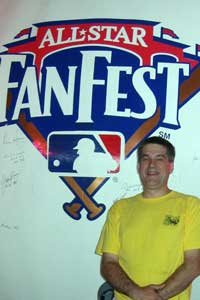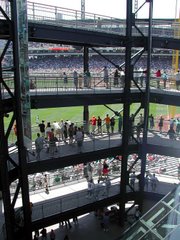My theory is that pitching is the primary culprit.
I'm not so sure that the quality of the pitchers in general is down. A number of future Hall of Famers -- Maddux, Glavine, Smoltz, Johnson, probably Clemens -- were stars throughout most of the '90s and still are effective today. And don't forget about guys like Pedro Martinez and Curt Schilling, who might not be bound for Cooperstown but still put up some tremendous numbers.
The problem with pitchers today is that in any given game, far too many of them make appearances.
You've seen managers in action. Six innings is enough for a starter who's pitched effectively. Setup Man No. 1 comes in for the seventh. Setup Man No. 2 for the eighth. Oops, he's in some trouble. A lefty comes in to face a left-handed hitter. The next batter is a righty, so in comes a right-handed pitcher. He's a bit wild, so another man trots in from the bullpen. If his team makes it through the eighth, the closer enters to -- if all goes well -- close.
Not only does that make for some very protracted games, but it might give the batters an advantage. Think about a pitcher just entering the game. He may be throwing heat with a fresh arm, but more than likely he has to make a few adjustments when he starts facing live hitting. The batter already is warmed up after the first several innings. All he has to do is get ahold of one of those first few tentative pitches, and there's another moonshot.
All right, I don't know how much of that I believe, myself. But I did some digging and came up with some interesting statistics. Starting in 1973, the advent of the designated hitter (and the first year I started analyzing box scores), there appears to be a correlation between the number of complete games thrown by pitchers and the number of home runs hit by batters.
These charts list the league leaders in team complete games and individual home runs (click on a chart for a closer look):


I the American League, complete games skyrocketed after the DH came into play, as there was no longer any need to pinch-hit for pitchers. In the first four years of the DH, the average home run total for an AL leader was a shade over 33, the lowest total for a comparable span since World War II (and laughable by today's standards). It took an expansion year in '77 to push the homer champ up to 39. Meanwhile, the top teams still were tossing more than 60 complete games per year.
The Billy Martin-led A's took it to the extreme with 94 CG in '80, but he's often been accused of blowing out his pitchers' arms, which in turn contributed substantially to the decline of the complete game. That deserves a closer examination later.
The National League didn't show much correlation in the '70s. But look what happened in the '90s, leading up McGwire-Sosa-Bonds. Pitchers had pretty much stopped going the distance, and balls flew out of the park at a record pace. Coincidence?
For the record, both leagues reached the point of no return -- the home run leader hitting more than the team CG leader, for good -- in 1986, the year of Mike Schmidt's final longball title.
Also for the record, the first recorded instance of an individual leading the league in home runs with more than the team leader in complete games was Harmon Killebrew in 1964. He went yard 49 times, and his team, the Twins, topped the circuit with 47 CG.
Trivia question 23: Who is the last pitcher to record 20 complete games in a season?









No comments:
Post a Comment